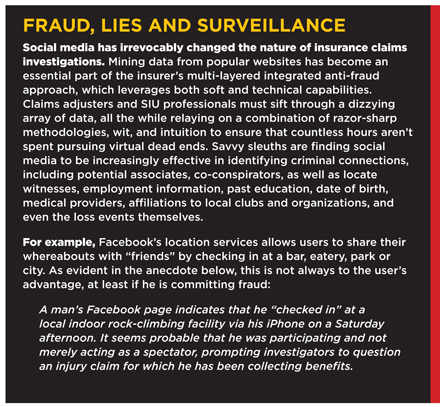In this business, we are intimately familiar with liars andtheir fibs and foibles, which are anything but pretty. Presumablyregistering high on narcissistic personality traits, some of themfind a comfortable place in today's culture of oversharing.Moreover, inadequate prosecutorial resources seem to embolden these liars,who, under the perceived impunity of social media, tout exploits asif to taunt insurance carriers and law enforcement agenciesalike.
|The Coalition's yearly roundup is a testament to scammers' brazen cunning, withtheir naiveté and recklessness often portrayed in nearly equalmeasure on Facebook, Twitter, and other social networking sites. Tothwart opportunistic fraud and address the proliferation oforganized crime rings, P&C insurers must employ an arsenal ofinvestigative techniques. As a growing number of claims managersand SIU directors can attest, multi-layered approaches to fraudtend to produce the most encouraging results, with social media asa key ingredient in investigative success.
|Sleuthing Or Snooping?
Social media inclaims investigations is certainly not a novel idea, though itsapplication is continually being refined. However, this veritableinvestigative goldmine—which can provide clues as to a claimant'sconnections, background, education, and whereabouts—is not withoutits caveats, including privacy concerns for which there is agrowing body of case law.
This is to say nothing of the legions of “John Smiths”(trying Googling him) who cry foul. Again, publicrelations challenges are anything but foreign to insurers. Eventhough insurance fraud has become a $30 billion-per-year racketaccording to the Insurance Information Institute (I.I.I.), thepublic remains somewhat apathetic, seemingly more concerned withthe possible encroachment of personal liberty than fraud's massivedrain on the economy, as well as the proverbial pocketbook in theform of higher premiums.
|Nevertheless, there is a startling amount of potentially usefulinformation in social media sites, with advanced analyticscontinually changing the face of claims investigation, as JamesRuotolo, principal for insurance fraud solutions at SAS, pointsout:
|“Technologies like text mining, sentiment analysis, contentcategorization and social network analysis can automate socialmedia research and be integrated into the fraud identification andpredictive modeling process,” he says. 
Such tools are useful in uncovering complex operations, such asthose abusing the Florida and New York personal injury protection(PIP) systems, along with more blatant cases of fraud—as inscammers incriminating themselves by posting pictures of engagingin adventure sports while collecting workers' compensationbenefits.
|Deceptively Simple
It's important to keepthat a claims investigation is rarely as simple as a Facebook userwith lax privacy settings and a penchant for recklessness. Inanother sense, social media serves as a useful, open-sourceintelligence research tool to identify leads and corroborateinformation.
Beyond injury claims, such as slip and falls and workers'compensation disputes, technology enabled social media intelligenceis enhancing fraud detection across auto, property, liability andother lines of business. Take, for example, the white paper titled,“Combating Insurance Claims Fraud” in which SAS details how itssocial-network analysis has proven effective in identifyingorganized fraud activities by modeling relationships betweenentities in claims.
|“Entities may be defined as locations, service providers,telephone numbers, and VINs,” according to the SAS report. “Toolscan be tuned to display link frequencies that exceed a programmedthreshold. Large volumes of seemingly unrelated claims can bechecked, and then patterns and problems identified.”
|“For example, social network analysismight show a high-activity account with links from many accounts,or a low-activity account with strong links to a master account,”SAS continues. “It might reveal multiple claims in a short periodof time from related parties, such as members of a single family,or the classic ring associated with staged accident scams.”
|In Capable Hands
In the fight againstfraud, it is important to keep in mind that there is no one magicbullet or given formula for success. All the technology andstrategy in the world will not compensate for a deficit in clever,skilled analysts to interpret and effectively procureinformation—both ethically and in keeping with state-specific rulesof discovery.
As Deloitte illustrates in its “Fight Insurance Fraud” report,which the consulting firm released in December 2012, on afundamental level, the heart of fraud-fighting operations is theSIU and the claims adjuster, who should be working towardthe organization's overarching fraud-fighting goal. In the report,Deloitte relays a compelling case study involving a large insurancecarrier:
|“The SIU function is now central and supported by regionalspecialists as needed. An element in the company's approach wasrebuilding core fraud investigative skills, including hiring formerFBI professionals and private investigators. In addition, itseparated and distinguished investigative skills from the basicadministrative skills required to support the SIU referral,preliminary investigation, and reporting.”
|When putting the pieces of the fraud puzzle together, claimsinvestigators must move swiftly and decisively, especially becauseinformation posted online has a definite “shelf life” for lack of abetter term. Crucial evidence must be discovered before it can betaken down. For example, eBay auctions invariably end. Users removeYouTube videos, vacation photos, and tweets.
|Regardless, investigators should not grow accustomed toscammers' naiveté about protecting personal data and coveringvirtual tracks to yield viable clues. They must instead availthemselves of cutting-edge technologies and some good old-fashioneddetective work.
Want to continue reading?
Become a Free PropertyCasualty360 Digital Reader
Your access to unlimited PropertyCasualty360 content isn’t changing.
Once you are an ALM digital member, you’ll receive:
- All PropertyCasualty360.com news coverage, best practices, and in-depth analysis.
- Educational webcasts, resources from industry leaders, and informative newsletters.
- Other award-winning websites including BenefitsPRO.com and ThinkAdvisor.com.
Already have an account? Sign In
© 2024 ALM Global, LLC, All Rights Reserved. Request academic re-use from www.copyright.com. All other uses, submit a request to [email protected]. For more information visit Asset & Logo Licensing.








